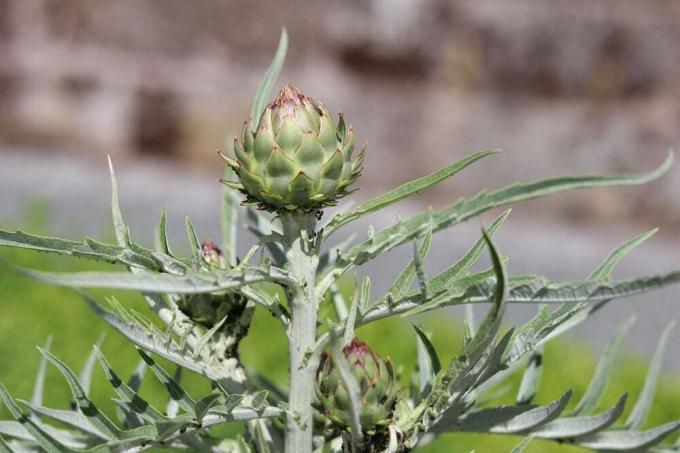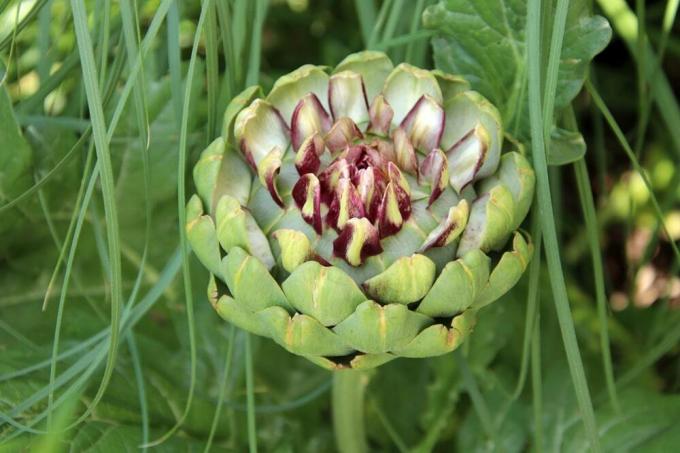
table of contents
- The right seeds
- Test seeds from your own harvest for germination
- Start sowing as early as possible
- The right location
- Basic care
- The best time to harvest
- Notes on wintering
- Select varieties according to regional climate
- frequently asked Questions
Artichokes are special vegetables because of their taste and their decorative, purple flowers. Artichokes can also be grown successfully in the home garden, provided you observe a few basic things.
In a nutshell
- Artichoke is a thistle-like plant that prefers Mediterranean climates
- Is generally perennial but not or only partially frost hardy in this country
- Can develop flower buds for up to five years with appropriate wintering
- Depending on the variety, often only develops a basal rosette of leaves or only a few edible buds in the first year
The right seeds
Good seeds are a prerequisite for germination. It can be harvested from existing artichokes or bought. When buying seeds, you should pay attention to their shelf life in order to ensure that they can germinate. It is also advisable to choose varieties that are reasonably hardy. In some cases there are notes on the seed sachets such as 'Restricted winter hardy' or 'To winter outside with winter protection'. Seeds you have picked yourself are best kept in a cool, dry place until they are ready for sowing.
Test seeds from your own harvest for germination
In order to test the germination ability of self-harvested seeds, you lay out a small bowl with cotton wool or cellulose and moisten it. Then distribute 10 seeds on it and place the bowl in a light and 20 degrees warm place. If five seeds start to germinate, the chance of germination is 50 percent.

Start sowing as early as possible
Prefer
If you prefer the plants from around mid-January, with a little luck they will start to bud in the first year. It is best to leave them for approx. Pre-soak in a glass of water for 24 hours to accelerate germination.
- Fill the growing container or small pots with loose growing soil
- Place pre-swollen seeds on the substrate and press down
- Three to four per pot
- Cover the seed 1-2 cm with soil
- Moisten the substrate and keep it evenly moist
- Put in a light and warm place
- The optimal germination temperature is 20-25 degrees
- First seedlings after two to three weeks
- After the first true leaves appear, lower the temperature to 15 degrees
- Plant the strongest specimens in the garden
Plant out in the garden
- Earliest time to plant out, after the ice saints
- Before planting, loosen the soil and enrich it with compost
- Three to five liters per square meter
- Maintain distances of 80-100 cm
- 150 cm recommended for multi-year cultivation
- Supply water regularly

The right location
In keeping with their natural habitat, the artichoke prefers warm and full sun locations with at least six hours of sun a day. In addition, it should be protected from rain and wind. This plant is also somewhat more demanding than other plants in terms of the nature of the soil. Since it is one of the deep-rooters, it needs a location with deep, well-drained and nutrient-rich soil. Sandy substrates are considered optimal.
Tip: Due to the fact that these plants form what are known as tap roots, cultivation in pots or pots is not recommended.
Basic care
The main components of care are the supply of water and nutrients. Artichokes need regular watering. They need plenty of water, especially during growth. Despite everything, waterlogging should be avoided at all costs. You should fertilize once or twice a year, ideally with manure or compost. Commercially available vegetable fertilizers and plant manure are just as suitable for fertilizing.

The best time to harvest
In the first year, August and September are the main harvest time. From the second year it is usually already in June / July to October. The harvest is then usually higher. The closed buds are harvested. The outer leaves, i.e. the bracts, should still be closed and close together. The individual leaves must not yet have brown tips. As soon as the flower opens, leave it on the plant and enjoy the beauty of the open flowers.
Notes on wintering
In well-protected locations, more robust varieties can withstand frost up to a maximum of minus 10 degrees. In rather mild locations and with appropriate protection, you can definitely dare to spend the winter outdoors.
In the bed
Overwinter outdoors can be successful if the winters are not too cold, although the degree of frost hardness naturally also depends on the variety.
- Before the first frost or Tie the leaves together after the harvest is over
- Cut off all the leaves
- Cut any remaining rung down to a few centimeters
- Cover with fleece, perforated foil
- Or approx. Pile about 30 cm high with a mixture of soil and sand
- With such protection, temperatures down to minus 12 degrees are tolerated
- Remove the cover again in early to mid-April
Tip: Overwintered artichokes are ready for harvest earlier in the second and third year and achieve significantly higher yields.

Overwinter frost-free
- Remove all leaves for a frost-free winter
- Dig up the rhizome and remove the earth
- Place the artichoke in large buckets with damp sand
- Place in a cool, frost-free room at around 15 degrees
- Pour something from time to time
- Plant in the bed again at the end of April
Tip: If you want to grow artichokes, you should generally pay attention to the crop rotation and plant them again in the same place after three years at the earliest.
Select varieties according to regional climate
If you want to grow this vegetable in your home garden, it is important to choose a variety that can cope with the local climate. A distinction is made between green purple varieties. Purple artichokes are much more sensitive but also less productive. Many love the sun, but are sensitive to rain. But they score with more intense and finer taste. In contrast, green varieties also tolerate colder temperatures but still do not tolerate severe frost. In addition, they are a little more resilient and robust.
Tip: If you want to grow artichokes in regions with particularly cold winters, it is better to use annual varieties. 'Vert Globe' and Vert de Provence ', for example, are good for this, as they form many flowers in the first year.
Well-known green varieties

Imperial Star
- Fast growing, big fruits
- Big buds in the first year
Camus de Bretagne
- Large, obtuse, 300-500 g, tender and fleshy bottom
Castel
- Round shape, very tender meat, good shelf life
Vert de Provence
- Fast-growing, smaller, elongated, pointed fruits, very tender
Spinoso sardo
- Intense green-purple, elongated variety
- Probably the tastiest
Madrigal F1
- Round-headed variety, stable, high-yielding
- Fleshy petals, large flower base
Purple varieties

Violet de Provence
- Elongated, pointed, very delicate
- If sown early, harvest late in the first year
Romanesco
- Old Italian variety, medium-sized, roundish
- Generous heart, individual segments and stem very tender
Violetto Chiogga
- Small elongated variety
- Pointed, loosely fitting purple outer and green inner leaves
frequently asked Questions
They can be kept in the refrigerator for up to three days. It is best to wrap them in a damp cloth and place them in the vegetable drawer. In no case wash before storage.
Keeping them in pots is difficult and often unsuccessful because of the tap roots. If you still want to try, the pot should have a capacity of at least 20-30 liters and, above all, be deep.
Young plants in particular should be protected from snail damage. Otherwise they can eat whole plants in damp weather. But aphids like the black bean louse also like to settle on the fleshy leaves. Beneficial organisms such as parasitic wasps, lacewing and ladybirds can be very helpful against them.


